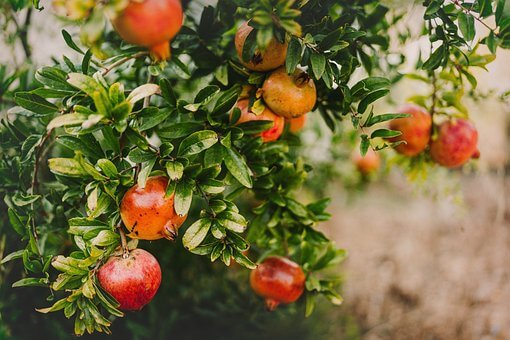
The pomegranate is a fruit that is typically seen in the fall and winter. It is often seen in the cornucopia at Thanksgiving or scattered amidst pine boughs at Christmas. The juice of the pomegranate is used in grenadine throughout the year and is full of antioxidants and vitamins. They’re an amazing addition to a healthy diet!
There is no other tree like the pomegranate tree. This foreign tree has become popular in the United States for its unique fruit that is full of tiny sacs of sweet juice.
This plant can be either a small fruit tree or a pretty shrub, making it a good choice for gardens of all sizes. We’re giving you all the tips you need to grow the happiest pomegranate trees possible!
All About The Pomegranate Tree
The pomegranate originated in Iran, but it quickly spread to India and other parts of the world once people discovered how delicious it is. Pomegranates were mentioned in mythology and religious literature and were present throughout history in Europe, Asia, and Africa. The Egyptians put it in their paintings; the Greeks told stories of Persephone eating only a few of them while she was in the Underworld. The Old Testament of the Bible praises it.
Somewhere in the late 1800’s, a plant called “Wonderful” made it to California. It became a popular fruit and was grown here. Although it is most commonly associated with the southern United States, it has also been grown in Mexico, South America, and other warm climates around the world.
This shrub can be grown as a small tree or left in its shrubby state. It needs to be trimmed back at the base if grown as a tree. Its leaves will fall off in cooler climates and stay on the plant in warm climates.
If you want to keep it as a shrub, it is often cut to be about 6 feet tall. Fruit trees can reach heights of up to 20 feet, but are often kept much shorter.
The flowers bloom in July and August and are a vibrant orange-red color. They’re quite beautiful, providing a colorful display on the tree. Female flowers, if pollinated, will turn to fruit. The base of the flower is firm and will become the bud end of the fruit. The petals and stamens may fall off as they dry.
The leaves are long and slender. In warm climates it may be evergreen. However, in most areas they will turn yellow. The tree will lose its leaves in the fall, and they will grow back in the spring.
Punica granatum, also known as the pomegranate tree, thrives in warm climates and is hardy in zones 8 through 11. Indoor pomegranate shrubs typically don’t perform well. The plant may have leaves and may even produce flowers, but it rarely produces fruit.
Cultivars to Select
There are hundreds of different types of pomegranates, each with their own name.
Some spices are better used for dye, or ground into powder to be used in dishes with strong flavors, such as those popular in Middle Eastern, Pakistani, and Indian cuisine. Others are better known for their distinctive flavors or the color and form of their fruit, such as purple or yellow varieties.
Purple Heart
This plant is also known as ‘Sharp Velvet.’ The fruit is large and red, with a sweet taste and low acidity. They’re typically ready for harvest in October.
Red Silk
The Red Silk variety of pomegranate is known for its slightly pink pericarp, and for being medium to large in size.
Wonderful
‘Wonderful’ is the most commonly sold variety of pomegranate in grocery stores. This plant grows to a height of 15-20 feet and is just as wide. It also produces a lot of fruit.
Growing Tips
- Select a location for planting with full sun exposure and loamy soil, or sandy loam.
- Provide supplemental water through the first year of growth, until plants become established.
- Be sure to allow adequate spacing between trees and away from structures and other plants, as standards can grow to be very large. Otherwise, select a dwarf cultivar.
Care
Light & Temperature
Pomegranates grow best in full sun. It will need at least 8 hours of sunlight per day for best growth, but can tolerate partial afternoon shade.
Pomegranates flourish in locations that experience lengthy, scorching summers and cool winters. 90’s Perfect areas during the summer. But by cool winters, I don’t mean serious cold.
These trees grow best in hardiness zones 8-11. For areas with colder climates, these plants can be grown in containers and brought inside during winter. However, once the temperature outside begins to rise again, they should be moved back outside. Provide plenty of light for your plants during the winter months!
Water & Humidity
Pomegranate trees can survive without much water, but they do better when they have access to plenty of water. Without liquid in the axils, shrubs and trees cannot grow properly.
The amount of watering your plants need depends on the amount of moisture in the soil. A thick layer of mulch will help to keep the moisture in the ground from evaporating and will also reduce how often you will need to water.
It can be difficult to determine how much water to give pomegranates because it varies depending on the climate they are in. The best times to water them more are during the hottest months of late spring, summer, and early fall. At these points, rain frequency is often less. Do not worry if it becomes a little dry before you add more moisture. Your pomegranate shrubs will survive.


Leave a Reply